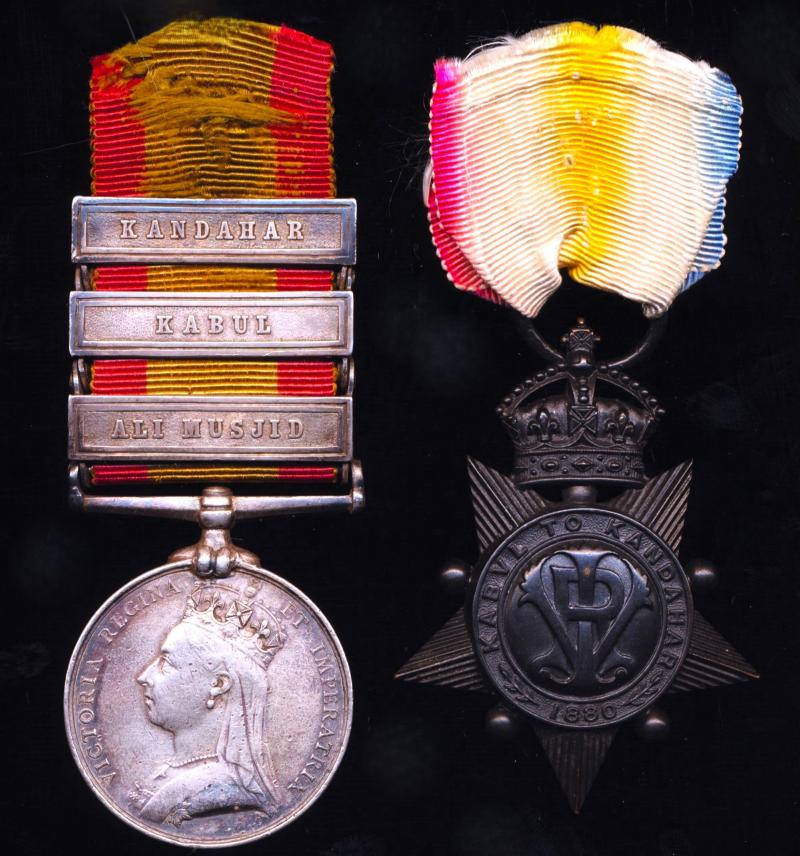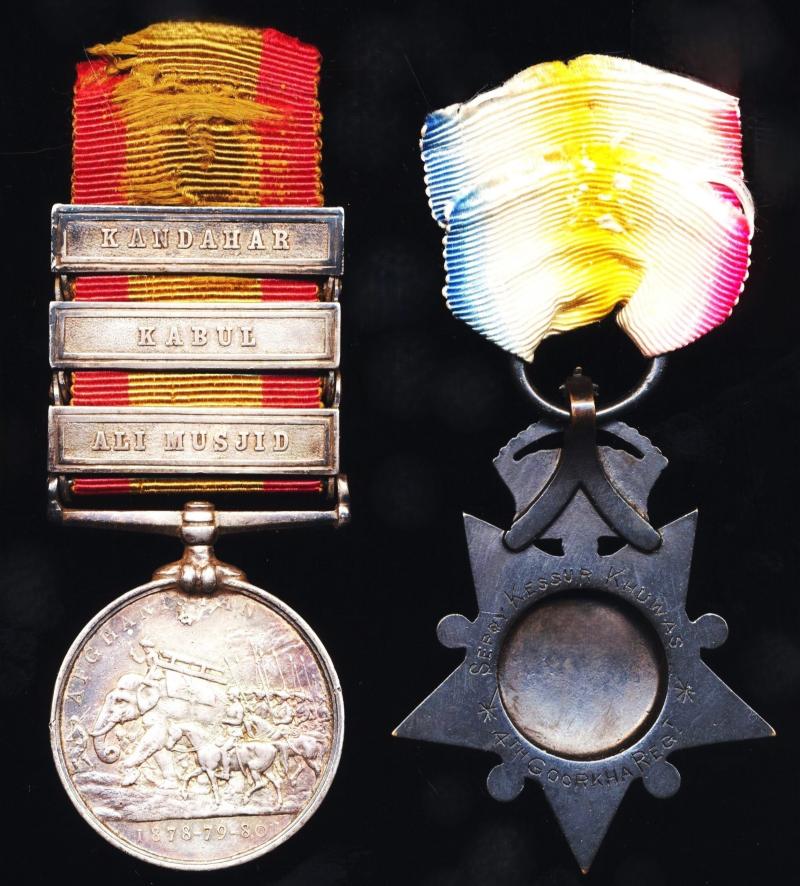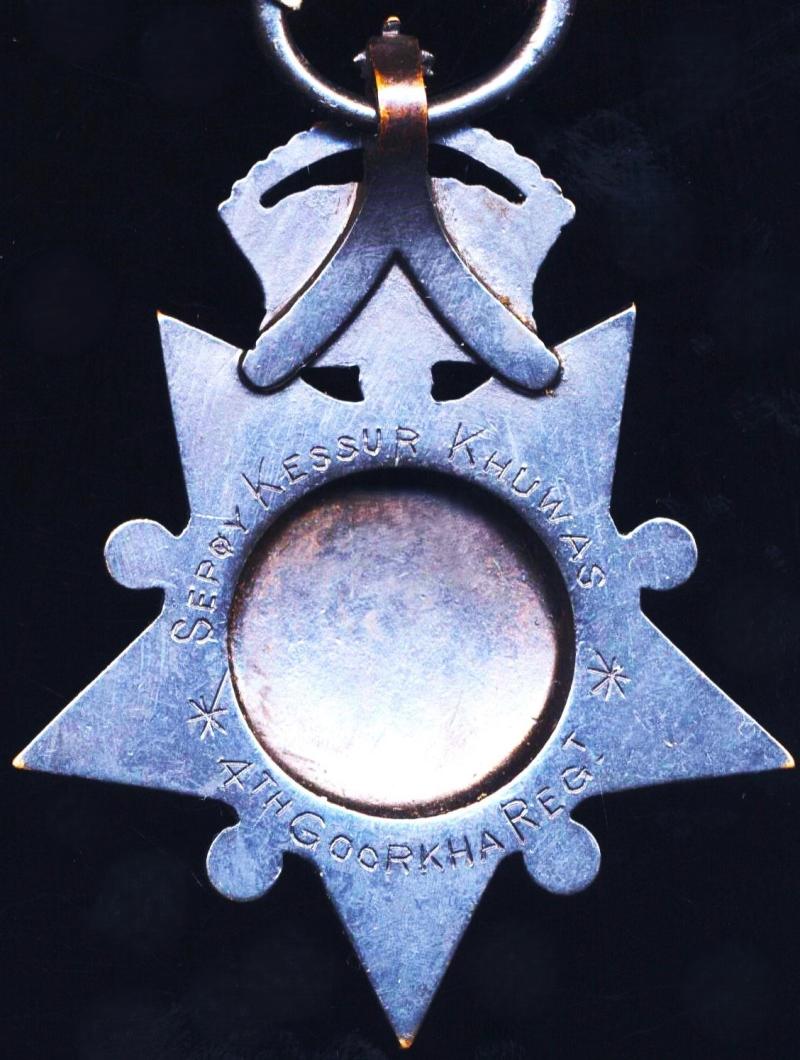A Gurkha Second Afghan War campaign medal pair: Sepoy Lall Sing Demaie, 4th Goorkha Regiment, later 4th Gurkha Rifles of the Indian Army
- Afghan 1878-80. Ali Musjid, Kabul & Kandahar (Sepoy Kessur Khuwas, 4th Goorkha Regt.)
- Kabul to Kandahar Star 1880 (Sepoy Kessur KhuwasLall Sing Demaie, 4th Goorkha Regt.)
The Afghan medal with contemporary reverse solder mark at suspender claw, where a loose claw has been fixed. The suspension in o/w very good swiveling order
Both medals retaining short old lengths of their original silk ribands
The recipient was by ethnicity and faith a Garhwali Hindu, who held the rank of Sepoy (Private) while serving with the 4th Goorkha Rifles Regiment, of the Bengal Army
Reference 'The Afghan Campaign 1878-1880' (S. H. Shadbolt, 1882), we are below providing the regiment's record of service during the Second Afghan War:
Quote,
4th GOORKHA REGIMENT
In September, 1878, the 4th Goorkha Regt. received orders to hold itself in readiness to proceed on active service, and on the 2nd Oct. marched from Bukloh for Peshawar, under the command of Lt.-Colonel P. J. Turton.
As a unit of the 1st Brigade 1st Division Peshawar Valley F.F., the regiment was engaged, on the 21st and 22nd Nov., in the difficult flanking operations which were conducted by Brigadier-General Macpherson over the precipitous Rhotas heights in reverse of Ali Musjid, and which contributed to effecting the abandonment of the Fort and the retreat of the Afghan forces. Accompanying the subsequent advance of the Division through the Khyber, the 4th Goorkhas took part, successively in the occupation of Daka, Jalalabad, and Gandamak.
In January, 1879, 200 picked men of the regiment under Major Rowcroft, forming a portion of Brigadier-General Tytler’s Column, marched from Basawal on the second expedition into the Bazar Valley, and the 28th of that month, in the reconnaissance of the Bokhar Pass, were hotly engaged the enemy contesting every hill-top for a distance of nearly five miles.
On the 31st March, 1879, 3°° picked men of the 4th Goorkhas, under Major Rowcroft, took part in Brigadier-General Macpherson’s expedition to the Lughman Valley, in pursuit of Azmatallah Khan, accomplishing a forced march of 26 hours’ duration, in which 35 miles of most difficult country, including the almost inaccessible range of the Siah Koh, were covered.
The campaign concluded, the regiment commenced its return march to India from Gandamak on the 2nd June, and eventually reached Bukloh on the 13th July, having been detained four days in cholera camp at Jhelum. Though, in common with the other regiments of the Division, its sufferings during the march were intense, it was fortunate in losing no more than 11 fighting men and a like number of camp followers from the fell disease which claimed so many victims.
On the renewal of hostilities in the autumn of 1879, the 4th Goorkhas was again ordered to the front, and marching from Bukloh on the 25th Sept., under the command of Lt.-Colonel Rowcroft, reached Gandamak, after a week’s detention at Jalalabad, on the 15th Nov.
As a unit of Brigadier-General Charles Gough’s brigade, the regiment marched from Gandamak on the 14th Dec. to Jagdalak, and in the fighting which ensued in the neighbourhood of that post—notably in the affairs of the 17th and 18th Dec.-took a prominent part. Continuing with the Brigade in its advance to the relief of Sherpur, the regiment arrived with it at its destination on the 24th Dec. On the 1st Jan., 1879, it moved into the Bala Hissar, which was occupied by Brigadier-General C. Goughs brigade until the end of March.
In the middle of April 1880, 4th Goorkhas accompanied the force under General Ross which moved out from Kabul to co-operate with the division under Sir Donald Stewart advancing from Ghazni, and took part in the operations which were conducted by it in the Maidan and neighbouring districts. In the action of Shekabad, on the 25th April, one wing of the regiment was engaged with the column of all arms, under the command of Lt.-Colonel Rowcroft, which defeated the enemy on the hills above Zaidabad, driving them, with heavy loss, from their numerous strong positions ; while the remaining four companies, under Major Mainwaring, were
occupied on the extreme left, watching a large force which was threatening a flank attack. For the steadiness and intelligence the men displayed in this action, the regiment received warm commendation in the Generals despatch.
In the middle of June, 1880, the 4th Goorkhas left Sherpur with Brigadier-General C. Goughs brigade for Pughman, and for the next six weeks, until the force was recalled to Sherpur in view of the evacuation of Kabul, took part with it in its various operations in the Koh Daman and surrounding districts. On the 28th June, four companies under Colonel Rowcroft, were engaged in the affair of Sofian, against Mir Butcha’s levies, the result of a reconnaissance on the road towards Istalif.
As a portion of the 3rd Brigade of the Kabul-Kandahar F.F., the 4th Goorkhas took part, in August, 1880, in the memorable march to the relief of Kandahar. On the 31st Aug. the regiment occupied the centre of the position taken up by MacGregor’s brigade in the village of Absabad when the Cavalry reconnaissance drew the enemy forward, and assisted in checking their advance by a well-directed fire; and after maintaining its position throughout the succeeding night, the regiment was engaged, on the 1 st Sept., in the battle of Kandahar, a half-company under Jemadar Ramu Thappa, which was sent up by Col. Rowcroft to clear a hill on the arrival of the Brigade near Ayub s camp, particularly distinguishing itself, shooting or bayoneting every Ghazi of forty-six who remained to defend the height.
On the 8th Sept, the 4th Goorkhas marched with MacGregor’s Brigade towards Quetta, and on the 16th idem formed part of a column of all arms which was detached at Killa Abdula, under the command of Col. Rowcroft, to restore order and collect supplies in the Panizai country. The column rejoined the brigade on the 27th Sept, at Kach, and the regiment subsequently took part with the latter in its expedition through the Marri country, eventually arriving at Rajanpur on the 16th Nov. From Rajanpur the regiment proceeded by rail to Umritsur, and from thence by route march to its own station, Bukloh, which it reached on the 9th Dec., 1880, after an absence of more than two years on service
Unquote.
Afghan Medal with usual edge contacts from the companion star, and re-fixed claw only, with tiny solder repair in top reverse field. The Kabul to Kandahar Star retaining all its original dark lacquer finish
A wonderful looking medal pair, left undisturbed for many years
Condition: Afghan toned VF, Star EF
Code: 24568






